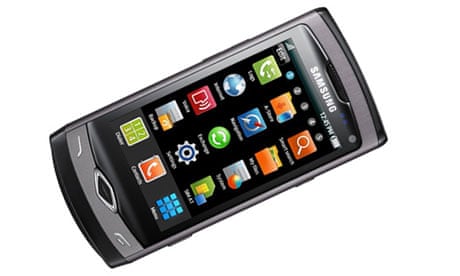What is it? Samsung Wave GT-S8500 – the first device to run Samsung operating system Bada.
Category: Hardware and software, given the newsworthy nature of operating systems these days.
You'd use it for... On the move, personal or business. It's not going to intrude on BlackBerry's ground as leading high-performance business mobile device, but the Wave sits happily as a phone suited to staying up to speed while on the move.
First impressions: what is it like to look at, to hold, to use? Perfectly good look and feel to the phone, a sturdy but slender shell encasing a fairly high-spec bit of mobile kit. It's when you activate the screen things start to go downhill.
The home screen – quite separate from the screen of apps – has six iterations as you swipe your finger right-to-left, inching across a background of some picturesque eastern European town square.
Each of these five modules is for housing a quick access single widget – but the access isn't so quick after four or five swipes of the finger. Navigating from the home screen to your downloaded apps directory takes another click. Granted, the software is snappy and quickly responsive, but these things all pile up in the "pointless" file.
And you can't swipe up to the URL bar in the browser, forcing you instead to press an on-screen button. Seems needless.
What does it really do well? Mobile internet has a well-suited clean font, made all the more appealing by the crisp super AMOLED screen. Put the Wave side by side with an iPhone 4 and a 3G – you'll see the difference. FYI: theguardian.com looks better on a Wave than a 3G.
Keyboard keys appear far too close together, but typing seems to work fine if not more usable than on the iPhone. When browsing the web, pinching zooms are clunky and not instantly responsive.
Video playback is impressive, on the eyes and the ears. Creating media is a good experience too, the 5MP camera shooting strong video and stills taking allowing nifty features like user-directed focus.
What's the cost? Around £300 sim-free; a 24-month contract with free handset will set you back between £25-£45 per month.
What's it up against? A smartphone market with less wiggle room than the App Store. It's a relatively ruthless market out there for high-end devices, software increasing in consumer importance at a rate of knots.
With Bada, Samsung is late to the party and forgot to invite its marketing muscle. For this reason alone, Wave falls short of the majority of recently released Android devices – Samsung has plenty of work to do before the release of Bada-powered Wave 2.
Blind us with the tech specs, then: Quite a few headline tech specs come with the Wave: the 5MP video/still camera will draw the punters – 5x zoom for stills and 720p video recording make the feature more than adequate; the Super AMOLED screen is a turn on, but likely only to the techies.
As light as any iPhone, the Wave is slimmer but only by a stitch. At 3.3 inch, the Wave screen limits its viability as a comfortable-to-use mobile internet device. With 2GB internal memory as standard, most users will require a MicroSD card (up to 32GB capacity).
What's it good for? Taking and sharing decent quality stills. It would be good for accomplishing tasks quickly if there weren't so many naggingly bad points of user experience making pretty much any task an exertion.
What are its failings? One word: Bada. A few more words: the cramped feeling while using SMS, the uneconomical use of the 3.3 inch screen made worse by the majority of the screen having a black (or very dark) background even when running apps.
Will I have to read the manual? Does anyone still read manuals? If new to Samsung, you may need to Google "Help! I've accidentally locked my Samsung Wave – what now?"
How long is the battery life? With its 3G signal sensor turned off, the battery will last you more than 24 hours from full – more than can be said for any iPhone before 4.
What's its USP? The Wave's USP would have to be the Super AMOLED screen which, on this score alone, puts it near top of the class for smartphones. That said, I don't know one single person who's been sold a phone on screen specifications – and it's not great marketing fodder either.
Rating out of 10: 6.5
Finally, is it worth it – yes or no? Not at the current price. There are countless devices (and countless yet to be released) doing a better job and with a better operating system. Don't hold out for the Wave 2.
